NCERT Solutions Class 10 Maths
Chapter – 10 (Circles)
The NCERT Solutions in English Language for Class 10 Mathematics Chapter – 10 Circles Exercise 10.2 has been provided here to help the students in solving the questions from this exercise.
Chapter : 10 Circles
Exercise – 10.2
In Q.1 to 3, choose the correct option and give a justification.
1. From point Q, the length of the tangent to a circle is 24 cm, and the distance of Q from the centre is 25 cm. The radius of the circle is
(A) 7 cm
(B) 12 cm
(C) 15 cm
(D) 24.5 cm
Solution – Let O be the centre of the circle.
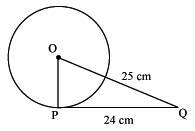
So, OP is perpendicular to PQ, i.e., OP ⊥ PQ
It is given that
OQ = 25 cm and PQ = 24 cm
By using Pythagoras’ theorem in △OPQ,
OQ2 = OP2 +PQ2
(25)2 = OP2+(24)2
OP2 = 625 – 576
OP2 = 49
OP = 7 cm
So, option A, i.e., 7 cm, is the radius of the given circle.
2. In Fig. 10.11, if TP and TQ are the two tangents to a circle with centre O so that ∠POQ = 110°, then ∠PTQ is equal to
(A) 60°
(B) 70°
(C) 80°
(D) 90°
Solution – It is given that TP and TQ are tangents.
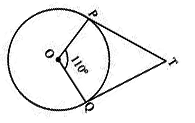
So, OP ⊥ PT and TQ ⊥ OQ
∴ ∠OPT = ∠OQT = 90°
In quadrilateral POQT,
Sum of all interior angles = 360![]()
∠OPT + ∠POQ + ∠OQT + ∠PTQ = 360![]()
⇒ 90![]() + 110º + 90
+ 110º + 90![]() +
+![]() PTQ = 360
PTQ = 360![]()
⇒ ∠PTQ = 70°
So, ∠PTQ is 70° which is option B.
3. If tangents PA and PB from a point P to a circle with centre O are inclined to each other at an angle of 80°, then ∠ POA is equal to
(A) 50°
(B) 60°
(C) 70°
(D) 80°
Solution – It is given that PA and PB are tangents.
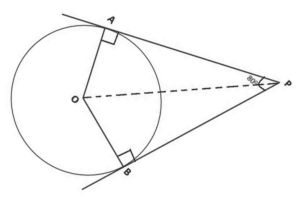
Now, in the above diagram, OA is the radius to tangent PA, and OB is the radius to tangent PB.
So, OA is perpendicular to PA, and OB is perpendicular to PB, i.e., OA ⊥ PA and OB ⊥ PB.
So, ∠OBP = ∠OAP = 90°
Now, in the quadrilateral AOBP,
The sum of all the interior angles will be 360°.
So, ∠AOB + ∠OAP + ∠OBP + ∠APB = 360°
Putting their values, we get
∠AOB + 90° + 90° + 80°= 360°
∠AOB + 260° = 360°
∠AOB = 100°
Now, consider the triangles △OPB and △OPA. Here,
AP = BP (Since the tangents from a point are always equal)
OA = OB (Which are the radii of the circle)
OP = OP (It is the common side)
Now, we can say that triangles OPB and OPA are similar using SSS congruency.
∴ △OPB ≅ △OPA
So, ∠POB = ∠POA
∠AOB = ∠POA+∠POB
2 (∠POA) = ∠AOB
By putting the respective values, we get
⇒ ∠POA = 100°/2 = 50°
As the angle ∠POA is 50°, option A is the correct option.
4. Prove that the tangents drawn at the ends of a diameter of a circle are parallel.
Solution – Let AB be a diameter of the circle. Two tangents PQ and RS are drawn at points A and B respectively.
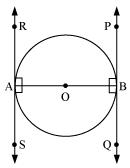
Radius drawn to these tangents will be perpendicular to the tangents.
Thus, OA ⊥ RS and OB ⊥ PQ
∠OAR = 90º
∠OAS = 90º
∠OBP = 90º
∠OBQ = 90º
It can be observed that
∠OAR = ∠OBQ (Alternate interior angles)
∠OAS = ∠OBP (Alternate interior angles)
Since alternate interior angles are equal, lines PQ and RS will be parallel.
5. Prove that the perpendicular at the point of contact to the tangent to a circle passes through the centre.
Solution – Let us consider a circle with centre O. Let AB be a tangent which touches the circle at P.
Draw QP ⊥ RP at point P, such that point Q lies on the circle.

∠OPR = 90° (radius ⊥ tangent)
Also, ∠QPR = 90° (Given)
∴ ∠OPR = ∠QPR
Now, the above case is possible only when centre O lies on the line QP.
Hence, perpendicular at the point of contact to the tangent to a circle passes through the centre of the circle.
6. The length of a tangent from point A at a distance 5 cm from the centre of the circle is 4 cm. Find the radius of the circle.
Solution – Let us consider a circle centered at point O.
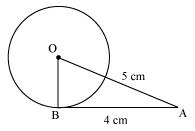
AB is a tangent drawn on this circle from point A.
Given that,
OA = 5cm and AB = 4 cm
In ΔABO,
OB ⊥ AB (Radius ⊥ tangent at the point of contact)
Applying Pythagoras theorem in ΔABO, we obtain
AB2 + BO2 = OA2
42 + BO2 = 52
16 + BO2 = 25
BO2 = 9
BO = 3
Hence, the radius of the circle is 3 cm.
7. Two concentric circles are of radii 5 cm and 3 cm. Find the length of the chord of the larger circle which touches the smaller circle.
Solution – Let the two concentric circles be centered at point O. And let PQ be the chord of the larger circle which touches the smaller circle at point A. Therefore, PQ is tangent to the smaller circle.

OA ⊥ PQ (As OA is the radius of the circle)
Applying Pythagoras theorem in ΔOAP, we obtain
OA2 + AP2 = OP2
32 + AP2 = 52
9 + AP2 = 25
AP2 = 16
AP = 4
In ΔOPQ,
Since OA ⊥ PQ,
AP = AQ (Perpendicular from the center of the circle bisects the chord)
![]() PQ = 2AP = 2 × 4 = 8
PQ = 2AP = 2 × 4 = 8
Therefore, the length of the chord of the larger circle is 8 cm.
8. A quadrilateral ABCD is drawn to circumscribe a circle (see Fig. 10.12). Prove that AB + CD = AD + BC
Solution – The figure given is:
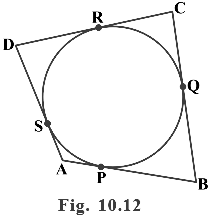
It can be observed that
DR = DS (Tangents on the circle from point D) ——— (1)
CR = CQ (Tangents on the circle from point C) ——— (2)
BP = BQ (Tangents on the circle from point B) ——— (3)
AP = AS (Tangents on the circle from point A) ——— (4)
Adding all these equations, we obtain
DR + CR + BP + AP = DS + CQ + BQ + AS
(DR + CR) + (BP + AP) = (DS + AS) + (CQ + BQ)
CD + AB = AD + BC
9. In Fig. 10.13, XY and X′Y′ are two parallel tangents to a circle with centre O and another tangent AB with the point of contact C intersecting XY at A and X′Y′ at B. Prove that ∠ AOB = 90°.

Solution – Let us join point O to C.
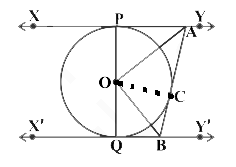
In ΔOPA and ΔOCA,
OP = OC (Radii of the same circle)
AP = AC (Tangents from point A)
AO = AO (Common side)
ΔOPA ![]() ΔOCA (SSS congruence criterion)
ΔOCA (SSS congruence criterion)
Therefore, P ↔ C, A ↔ A, O ↔ O
∠POA = ∠COA —————— (i)
Similarly, ΔOQB ![]() ΔOCB
ΔOCB
∠QOB = ∠COB —————— (ii)
Since POQ is a diameter of the circle, it is a straight line.
Therefore, ∠POA + ∠COA + ∠COB + ∠QOB = 180º
From equations (i) and (ii), it can be observed that
2∠COA + 2 ∠COB = 180º
∠COA + ∠COB = 90º
∠AOB = 90°
10. Prove that the angle between the two tangents drawn from an external point to a circle is supplementary to the angle subtended by the line segment joining the points of contact at the centre.
Solution – Let us consider a circle centered at point O. Let P be an external point from which two tangents PA and PB are drawn to the circle which are touching the circle at point A and B respectively and AB is the line segment, joining point of contacts A and B together such that it subtends ∠AOB at center O of the circle.
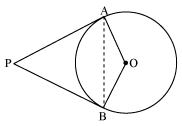
It can be observed that
OA (radius) ⊥ PA (tangent)
Therefore, ∠OAP = 90°
Similarly, OB (radius) ⊥ PB (tangent)
∠OBP = 90°
In quadrilateral OAPB,
Sum of all interior angles = 360º
∠OAP +∠APB+∠PBO +∠BOA = 360º
90º + ∠APB + 90º + ∠BOA = 360º
∠APB + ∠BOA = 180º
Hence, it can be observed that the angle between the two tangents drawn from an external point to a circle is supplementary to the angle subtended by the line-segment joining the points of contact at the centre.
11. Prove that the parallelogram circumscribing a circle is a rhombus.
Solution – Since ABCD is a parallelogram,
AB = CD ————– (i)
BC = AD ————– (ii)
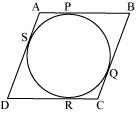
It can be observed that
DR = DS (Tangents on the circle from point D)
CR = CQ (Tangents on the circle from point C)
BP = BQ (Tangents on the circle from point B)
AP = AS (Tangents on the circle from point A)
Adding all these equations, we obtain
DR + CR + BP + AP = DS + CQ + BQ + AS
(DR + CR) + (BP + AP) = (DS + AS) + (CQ + BQ)
CD + AB = AD + BC
On putting the values of equations (i) and (ii) in this equation, we obtain
2AB = 2BC
AB = BC ————– (iii)
Comparing equations (i), (ii), and (iii), we obtain
AB = BC = CD = DA
Hence, ABCD is a rhombus.
12. A triangle ABC is drawn to circumscribe a circle of radius 4 cm such that the segments BD and DC into which BC is divided by the point of contact D are of lengths 8 cm and 6 cm, respectively (see Fig. 10.14). Find the sides AB and AC.
Solution – Let the given circle touch the sides AB and AC of the triangle at point E and F respectively and the length of the line segment AF be x.

From the diagram, BD = 8 cm, CD = 6 cm
Let, AE = AF = x (The lengths of tangents drawn from an external point to a circle are equal)
CD = CE = 6 cm (Tangents from point C)
BD = BF = 8 cm (Tangents from point B)
Using Heron’s formula, area of the triangle = √s (s – a)(s – b)(s – c)
where
s = 1/2 (a + b + c)
a, b and c are sides of a triangle
a = AB = x + 8
b = BC = 8 + 6 = 14
c = CA = 6 + x
s = 1/2 ( x + 8 + 14 + 6 + x)
s = 1/2 (2x + 28)
s = x + 14
Area of ΔABC = √(x + 14) ( x + 14 – x – 8)( x + 14 – 14)( x + 14 – x – 6)
= √( x + 14) × (6) × (x) × (8)
= √48x ( x + 14)
= √48 (x² + 14x) square units —————— (i)
Area of ΔABC = Area of ΔAOC + Area of ΔAOB + Area of ΔBOC
= 1/2 ( x + 6) × 4 + 1/2 ( x + 8) × 4 + 1/2 (14 × 4) [Since area of a triangle = 1/2 × l × b × h]
= 2x + 12 + 2x + 16 + 28
= 4x + 56
= 4( x + 14) square units —————— (ii)
Equating (i) and (ii)
√48 (x² + 14x) = 4(x + 14)
Squaring both sides
48(x² + 14x) = 4² (x + 14)²
48(x² + 14x) = 16 (x² + 28x + 196) [Using (a + b)² = a² + 2ab + b²]
48/16 (x² + 14x) = x² + 28x + 196
3x² + 42x = x² + 28x + 196
3x² – x² + 42x – 28x – 196 = 0
2x² + 14x – 196 = 0 (divide this equation by 2)
x² + 7x – 98 = 0
Solving by factorization method,
x² + 14x – 7x – 98 = 0
x ( x + 14) – 7 ( x + 14) = 0
( x + 14)( x – 7) = 0
x + 14 = 0 and x – 7 = 0
x = – 14 and x = 7
Since x represents length, it cannot be negative.
∴ x = 7
AB = a = x + 8 = 7 + 8 = 15 cm
AC = c = 6 + x = 6 + 7 = 13 cm
Thus, AB = 15 cm and AC = 13 cm
13. Prove that opposite sides of a quadrilateral circumscribing a circle subtend supplementary angles at the centre of the circle.
Solution – We know that tangents drawn from a point outside the circle, subtend equal angles at the centre.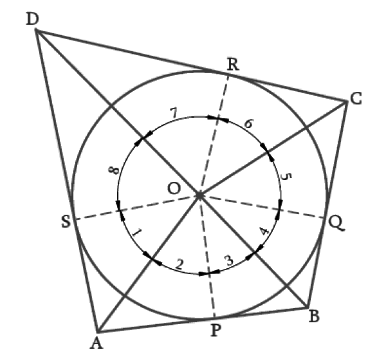
In the above figure, P, Q, R, S are points of contact
AS = AP (The tangents drawn from an external point to a circle are equal.)
∠SOA = ∠POA = ∠1 = ∠2 (Tangents drawn from a point outside of the circle, subtend equal angles at the centre)
Similarly,
∠3 = ∠4, ∠5 = ∠6, ∠7 = ∠8
Since complete angle is 360° at the centre,
We have,
∠1 + ∠2 + ∠3 + ∠4 + ∠5 + ∠6 + ∠7 + ∠8 = 360°
2 (∠1 + ∠8 + ∠4 + ∠5) = 360° (or) 2 (∠2 + ∠3 + ∠6 + ∠7) = 360°
∠1 + ∠8 + ∠4 + ∠5 = 180° (or) ∠2 + ∠3 + ∠6 + ∠7 = 180°
From above figure,
∠1 + ∠8 = ∠AOD, ∠4 + ∠5 = ∠BOC and ∠2 + ∠3 = ∠AOB, ∠6 + ∠7 = ∠COD
Thus we have,
∠AOD + ∠BOC = 180° (or) ∠AOB + ∠COD = 180°
∠AOD and ∠BOC are angles subtended by opposite sides of quadrilateral circumscribing a circle and the sum of the two is 180°.
Hence proved.

Leave a Reply